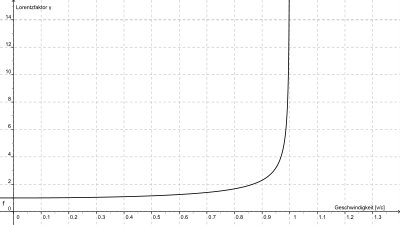Lorentz factor
The dimensionless Lorentz factor γ 
The Lorentz factor is defined as:
denotes the relative velocity of two reference systems.
- The speed of light
is a natural constant independent of the reference frame.
The following applies to reference systems at rest relative to each other
If 
Thus, through a Taylor development
At which order the evolution can be terminated in classical physics cannot be answered in general. For most applications, γ 

Lorentz factor for accelerations
The time derivative of γ 



It follows directly:
and one obtains for the time derivative of the Lorentz factor:
and thus for the correct relationship between force and acceleration:
Lorentz factor as a function of momentum p
The Lorentz factor can also be expressed as:
with
- the relativistic momentum
of the object under consideration
- its mass
This notation is mainly found in theoretical physics.
The equivalence can be proven by an equation with the "normal" Lorentz factor, which yields the relativistic momentum.
Lorentz factor as a function of kinetic energy
The Lorentz factor can also be expressed as:
with
- the kinetic energy
of the considered object
- of its rest energy
Questions and Answers
Q: What is the Lorentz factor?
A: The Lorentz factor is a factor by which time, length, and mass change for an object moving at relativistic speeds (close to the speed of light).
Q: Who is it named after?
A: The Lorentz factor is named after Dutch physicist Hendrik Lorentz.
Q: What equation describes the Lorentz factor?
A: The equation for the Lorentz factor is gamma = 1/(sqrt(1-(v/c)^2)), where v is the speed of the object and c is the speed of light.
Q: What does (v/c) represent in this equation?
A: In this equation, (v/c) represents beta (beta), or the ratio between an object's velocity and that of light.
Q: How can we rewrite this equation?
A: We can rewrite this equation as gamma = 1/(sqrt(1-beta^2)).
Search within the encyclopedia













